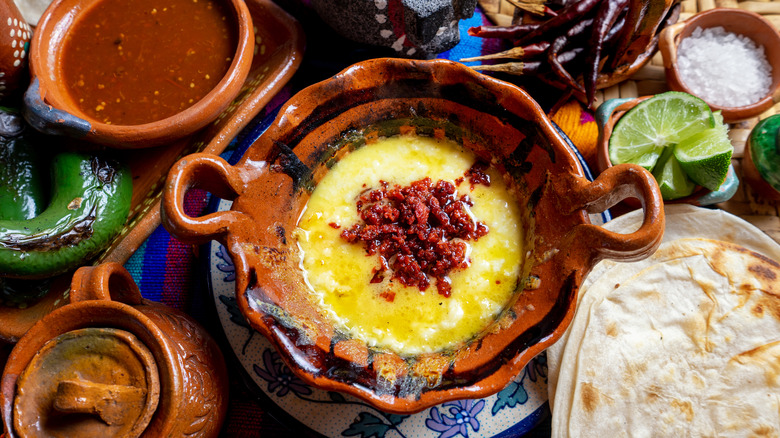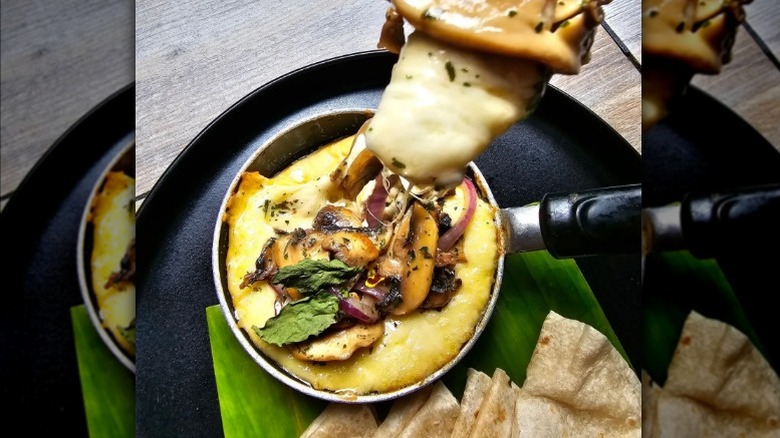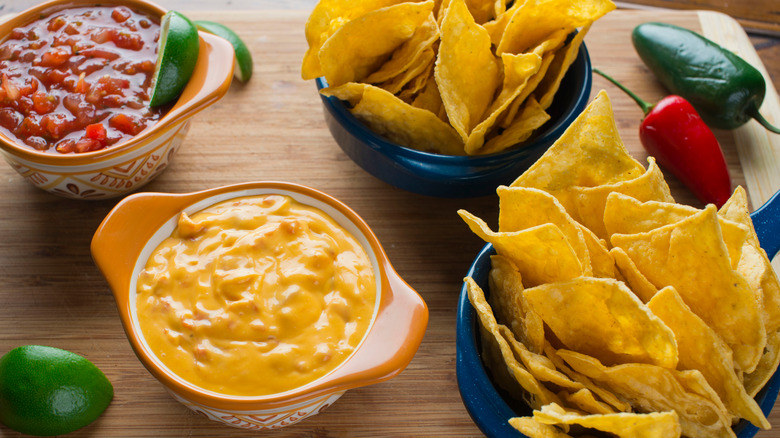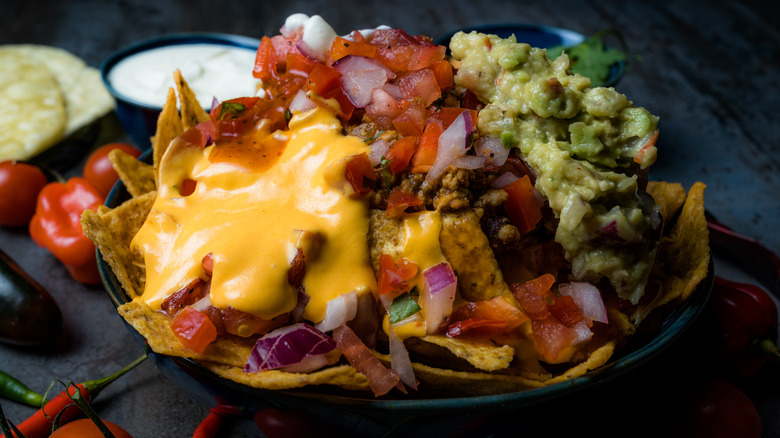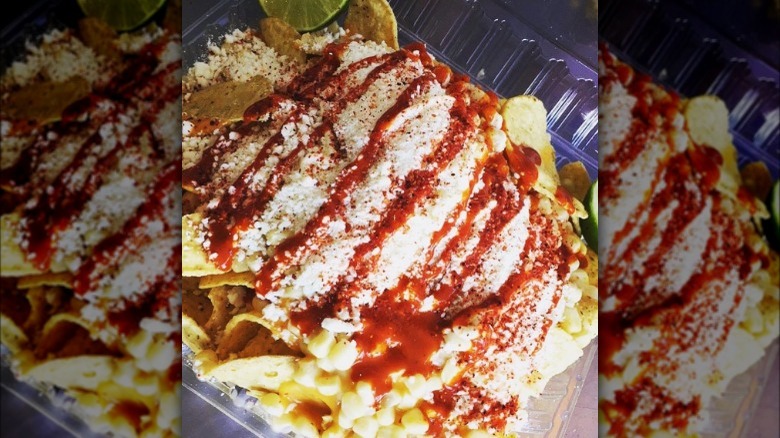What's The Difference Between Queso And Queso Fundido?
Both queso and queso fundido are culinary heavyweights in their own right. Some might argue that American queso, also called chile con queso or cheese dip, is a watered-down version of the original, queso fundido, but that is akin to erasure. Queso is a simple, flavorful, ultra-creamy delight, and though its roots are in the more sophisticated Mexican queso fundido, queso has bloomed into its own gastronomic feature. Queso fundido, though somewhat less common in the United States, is a delectable cheese-centric dish and is worth getting to know even for the biggest processed cheese purist.
Queso fundido is made with fresh cheeses, melted until stretchy and creamy, and topped with a variety of flavorful accouterments like chorizo, mushrooms, onions, and peppers. It is served with a stack of fresh tortillas. Queso, at its most basic, is made with a block of processed cheese, like Velveeta, but can also be made with a roux base with a variety of cheeses melted in. It is served with tortilla chips, and while often served simply, it can also be topped with any number of nacho-like toppings.
Back to basics – queso fundido
There are many regional variations of queso fundido, but no exact history. However, Mexican indigenous people did not consume dairy until after Spanish colonizers brought milk-producing livestock with them in 1500's.
Queso fundido requires cheeses that melt easily and combine well, like queso asadero (also called queso quesadilla), queso Chihuahua (also called queso Menonita), and queso Oaxaca (also called quesillo). Mexican queso Manchego can also be used. It is made with cow's milk, and is milder and meltier than the Spanish sheep's milk cheese of the same name. In Oaxaca, tangy queso fresco is added to quesillo. Mexican cheeses give that quintessential taste, but Muenster, Monterrey jack, and mozzarella are good substitutes.
Shredded cheese is combined in a cast iron or clay pan, and melted on the stove, oven, or grill. The cheese should be creamy and form a lightly crisp crust, called a costra. Savory chorizo, grilled onions, sauteed mushrooms, and charred strips of poblano peppers called rajas are all popular toppings, but you can also find grilled meats, a variety of vegetables, or huitlacoche, a "prized" fungus that grows on corn, per Texas Monthly.
In some areas, the dish is served flameado, or flaming, where liquor is poured on the melted cheese and lit on fire for a particularly dramatic entrance. The bubbling pan of melted cheese, adorned with richly flavored accompaniments, is spooned by each diner into a corn tortilla, or in Northern Mexico, a flour tortilla and topped with bright salsa for a build-your-own cheese taco.
Where did queso come from?
Whether served in a slow cooker or a small plastic molcajete at an oilcloth-covered Tex-Mex table, American chile con queso is a more than 100-year-old classic that's here to stay. The story of queso is another one where the foods of a certain community changed to accommodate the American palate.
According to The New Yorker, the earliest mentions of queso date back to magazine publications of an 1896 recipe for chiles verdes con queso and a 1914 recipe for Mexican rarebit, which would have been recognizable to today's queso fans and included American cheese. In 1900, the Original Mexican Restaurant, a Tex-Mex restaurant designed to appeal to white folks, was opened by Otis Fanworth in San Antonio, Texas. This is likely where Chile con queso was popularized. A women's organization in San Antonio also published a cookbook in the early 1920s with a recipe for chile con queso.
Processed American cheese, designed to be shelf-stable, was very popular around this time. One James Lewis Kraft patented a version in 1916. Velveeta was created in the 1920s and later sold to the Kraft company. Canned Ro-Tel tomatoes and green chilies, created by Carl Roettele in 1943, and Velveeta became a perfect advertising match. Melting a block of processed cheese with a can of lightly spicy tomatoes made queso accessible to the masses, since even in Texas, fresh chilies were expensive and hard to come by at the time.
How do you eat queso?
The most important quality of queso is a homogenized creaminess achieved by the use of processed cheese. Processed cheese contains sodium phosphate or sodium citrate, ingredients that act as stabilizing and emulsifying agents.
To this day, making a batch of queso can still be as simple as melting together Velveeta and Ro-Tel in the crock pot or microwave. Fancier versions will substitute part of the processed cheese for other cheeses to add a more interesting flavor and texture. Alternatively, queso can start with a base of butter and flour cooked together, a roux, with additions of milk and a combination of cheeses.
El Paso-style queso straddles the line between queso fundido and chile con queso. The simplest versions combine evaporated milk, roasted green chilies, and cream cheese, but also often includes white cheddar, queso asadero, muenster, or Monterey jack.
Like queso fundido, queso can also be loaded up with toppings like sour cream, seasoned ground beef, guacamole, pickled jalapenos, and pico de gallo. While queso fundido is typically served up simply with tortillas, queso can adorn not just tortilla chips, but fries, burritos, and burgers as well. It is not uncommon to see queso paired with another Tex-Mex classic, brisket.
An interdependent exchange of (cheese) cultures
Mexican and American culture is inextricably tied. Afterall, up until 1821, the country of Mexico included all of present-day California, New Mexico, Arizona, Nevada, Utah, Texas, and parts of Colorado, Kansas, Oklahoma, and Wyoming. The Rio Grande River did not become the official Texas-Mexico border until 1848.
These culinary traditions didn't get neatly packed and sent across the border — they melted together. Just as both more traditional queso fundido and Tex-Mex queso can be found in the United States, the same is true for Mexico. These days, American-style queso is available in Mexico, usually in pouches or cans, under the name salsa de queso or salsa nacho — cheese sauce or nacho sauce. It is a popular topping for snacks and fast food like hot dogs, street corn, and loaded nachos with Mexican additions like queso cotija and chamoy.
This particular melted cheese tradition originated in Mexico, molded as it spread across the United States, and made it back to Mexico as this distinct version. Queso fundido is still much more common in Mexico, but the cultural exchange and evolution are interesting to note. The point is, melted cheese is one of the best things ever, no matter which version you are enjoying.

